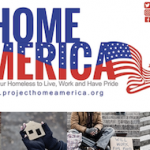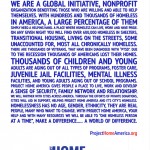As a polar vortex brings subzero temperatures across the U.S. Midwest this week, communities are looking for ways to support one of the most vulnerable groups: people who are homeless.
The National Weather Service has warned of “DANGEROUSLY low” wind chills over the next couple of days across Minnesota, Wisconsin, Illinois and other Midwestern states. Wind chills are expected to drop as low as minus 60 degrees Fahrenheit, with the Chicago-based weather service calling out the “potentially life threatening cold.”
Chicago public schools have announced they will be closed on Wednesday as a safety measure, and the city’s O’Hare International Airport has canceled over 100 flights due to “the extreme cold.”
City officials are warning people to bundle up and stay inside. But for individuals who are homeless and spend significant time outdoors, it’s not always easy to find respite from inclement weather.
With this in mind, officials across the region are taking action to provide extra support to their homeless populations. Chicago Mayor Rahm Emanuel said the city is adding shelter beds and deploying “warming buses.”
When it comes to how ordinary people can help homeless neighbors during cold weather, it’s also critical not to forget homelessness is an ongoing crisis year-round that demands political action, said John Tribbett, street outreach manager at Minneapolis’ St. Stephen’s, which operates shelters serving over 1,000 people per year.
“We’re dealing with this emergency every day. It’s just the cold weather makes it real for others,” Tribbett said, noting what he called the “larger systemic issue” of homelessness and the lack of affordable housing in communities across the country. “The real story is the tragedy we have in this country that leads to so many people being homeless on the street in the first place.”
The number of homeless people in the United States increased for the second year in a row in 2018, a setback after several years of progress. About 553,000 people nationwide were homeless on a single night in January 2018, per a report from the Department of Housing and Urban Development. Of those who were homeless, about two-thirds stayed in shelters or transitional housing, while about one-third were considered “unsheltered,” sleeping on the street, in abandoned buildings or other places “not suitable for human habitation.”
In terms of how to help this week, Chicago’s Coalition for the Homeless recommends calling 311 to get information about which local warming centers or shelters you can direct people to. In Illinois, officials are opening field houses in parks as well as other public spaces as warming centers across the state; in Minnesota, there will be warming centers in buses, libraries, churches and other places.
But when it dips into really freezing temperatures, call 911 emergency services if you see someone sleeping or staying outdoors, Tribbett suggested.
“This is really a historic event in terms of the dangers it presents to people living outside. Every year people lose limbs ― ears, toes ― to frostbite,” he said, noting the phones in their office have been “ringing non-stop” with tips about people who are outdoors or coming into shelters underdressed for the weather. “Honestly when it gets to be this cold, it’s a 911 call,” he stressed.
Some homeless shelters have asked for donations of public transportation cards or outerwear, per the Chicago Coalition for the Homeless. St. Stephen’s has an Amazon wish list people can donate to that includes gloves, toe warmers and long underwear for their clients.
But often the best way to help is by donating cash. Giving additional money to cover operating costs is “one of the most powerful things you can do” for smaller nonprofits operating overtime in inclement weather, Tribbett said. He suggested calling local shelters to see what their needs are. For some it will be cash, others donated items, and others still volunteers to help make meals.
“If you buy someone a cup a coffee in this weather and that keeps them inside for a couple hours that’s great,” Tribbett added. “But then you go home and sit with your cup of coffee and write some letters to politicians to bring about some change.”







